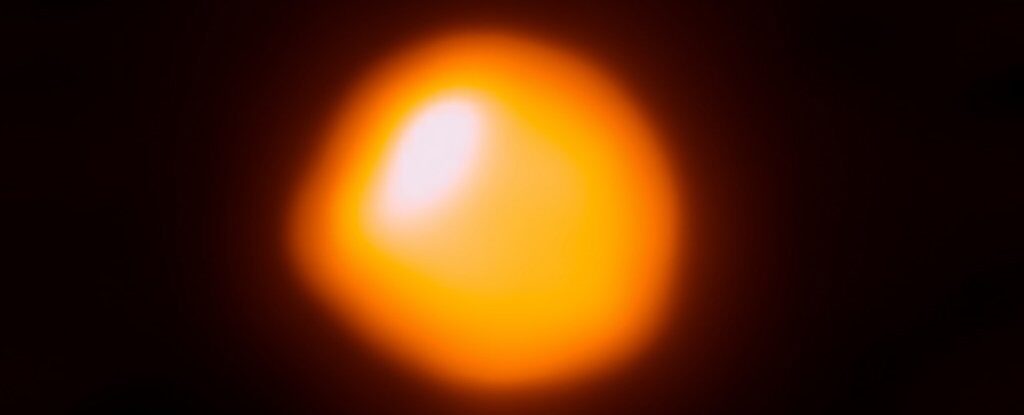According to the team led by researchers at Australian National University (ANU), the results change a few important things about our favourite red giant.
"The actual physical size of Betelgeuse has been a bit of a mystery - earlier studies suggested it could be bigger than the orbit of Jupiter," says astronomer László Molnár from the Konkoly Observatory in Hungary.
"Our results say Betelgeuse only extends out to two thirds of that, with a radius 750 times the radius of the Sun."
Betelgeuse has always been somewhat difficult to map with much accuracy. Forget the textbook picture of a star, spinning neatly as a relatively smooth sphere, and picture something more like a pulsating blob with fuzzy edges.
In 1920, interference patterns among its light waves were used to come up with an angular diameter - the width of Betelgeuse's starlight as it hangs in our sky - of close to 47 milliarcseconds.
Based on an assumed distance of around 180 light years, the red star was initially thought to have a diameter equivalent to around two and a half times the distance between Earth and the Sun.
Since then there have been many more attempts to drag a metaphorical measuring tape around Betelgeuse's butt.
Revisions of its location in the past few years pushed it further back to a distance of 724 light years away, where those 47 milliarcseconds represented something more like 1,300 times the diameter of the Sun; a diameter that would see Betelgeuse swallow up planets roughly in Jupiter's orbit.
Such numbers, including numerous stabs at its overall mass, paint a picture of a supergiant star rapidly approaching a stage in its life when it will theoretically collapse and explode in a shining ball of amazing that would be visible to the naked eye.
Unexpected dimming in the star's luminosity in recent years even drew excited whispers of whether it was some sort of Betelgeuse death wheeze, turning all of us stargazers into ghoulish relatives at a rich aunt's hospital bed.
It's now believed that clouds of dust were responsible for at least one of the events. And the other one, it seems, shows just how healthy our old Aunt Betelgeuse is.
"We found the second smaller event was likely due to the pulsations of the star," says ANU astrophysicist Meridith Joyce, who led the study.
Comment: So while the reasons provided may explain the unusual behaviour, it's possible there are other factors involved or other explanations altogether.
Pulsations like those observed in Betelgeuse are typically the result of pressure waves coursing through the burning innards of a star. Our own Sun has waves rippling throughout its body, which tells a lot about its makeup deep inside.
Using information collected with the space-based Solar Mass Ejection Imager prior to Betelgeuse's recent drop in luminosity, the research team developed models of the star's activity to come up with a better sense of just how close to retirement it really was.
"It's burning helium in its core at the moment, which means it's nowhere near exploding," says Joyce.
"We could be looking at around 100,000 years before an explosion happens."
The results also allowed the researchers to deduce the giant's radius, shaving a third off its previous girth. Based on this new figure, Betelgeuse can't be more than 700 light years away, either.
"Our results show it's a mere 530 light years from us - 25 per cent closer than previous thought," says Molnár.
Look, we're all a little disappointed. It's been four centuries since a supernova has been observable to the naked eye, and we feel we're owed a decent star funeral.
Now that we know Betelgeuse is even closer to us than we thought, it's sure to be one heck of a display when it does eventually collapse. If you're at all concerned about the new seating arrangements, at 530 light years we still won't be close enough to feel the heat of its radiation either.
For whatever passes for a scientist in 100,000 CE, these front row seats will certainly be an opportunity.
"It's still a really big deal when a supernova goes off. And this is our closest candidate. It gives us a rare opportunity to study what happens to stars like this before they explode," says Joyce.
This research was published in The Astrophysical Journal.




Comment: See also: Betelgeuse's mysterious dimming due to a traumatic outburst - NASA